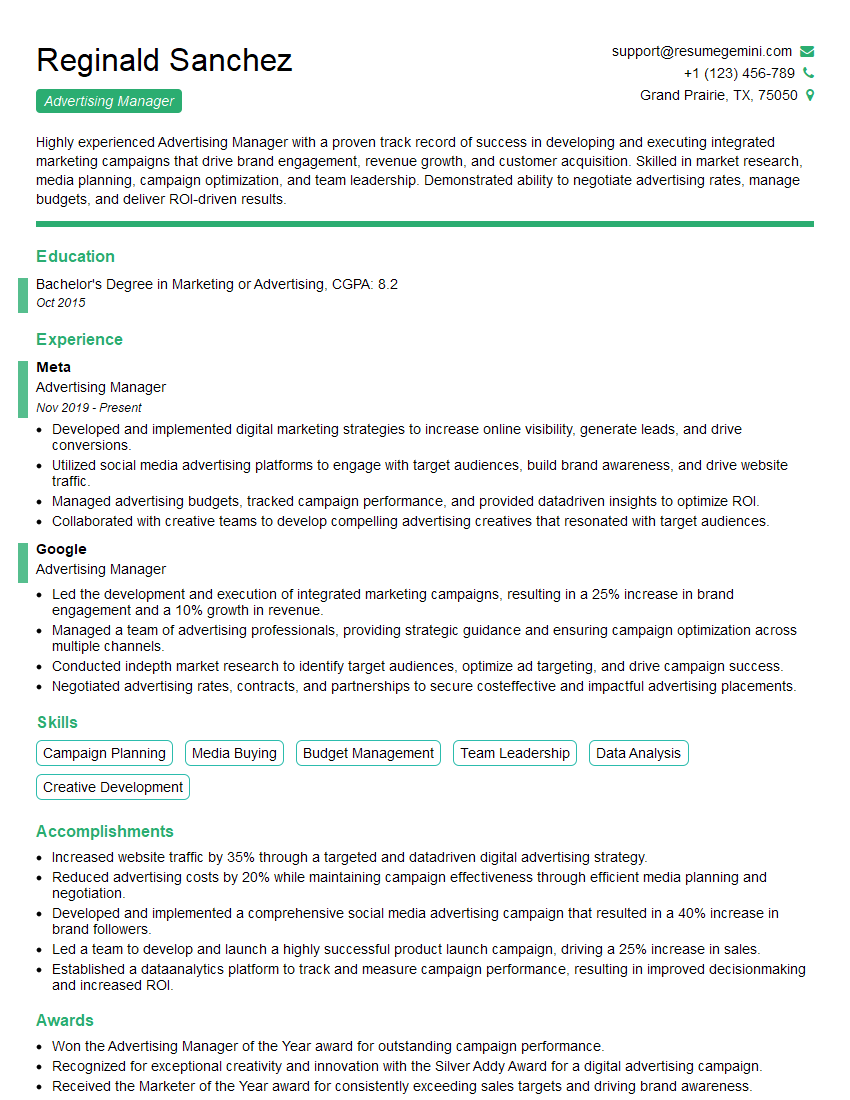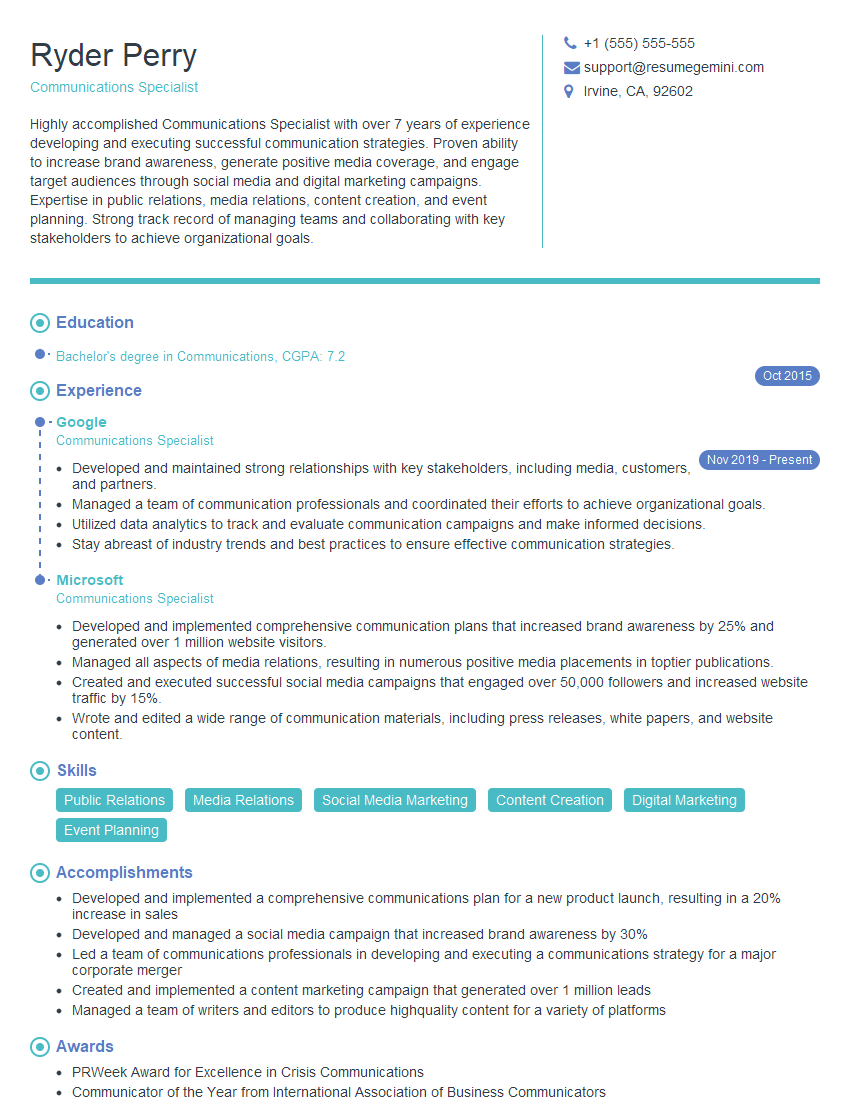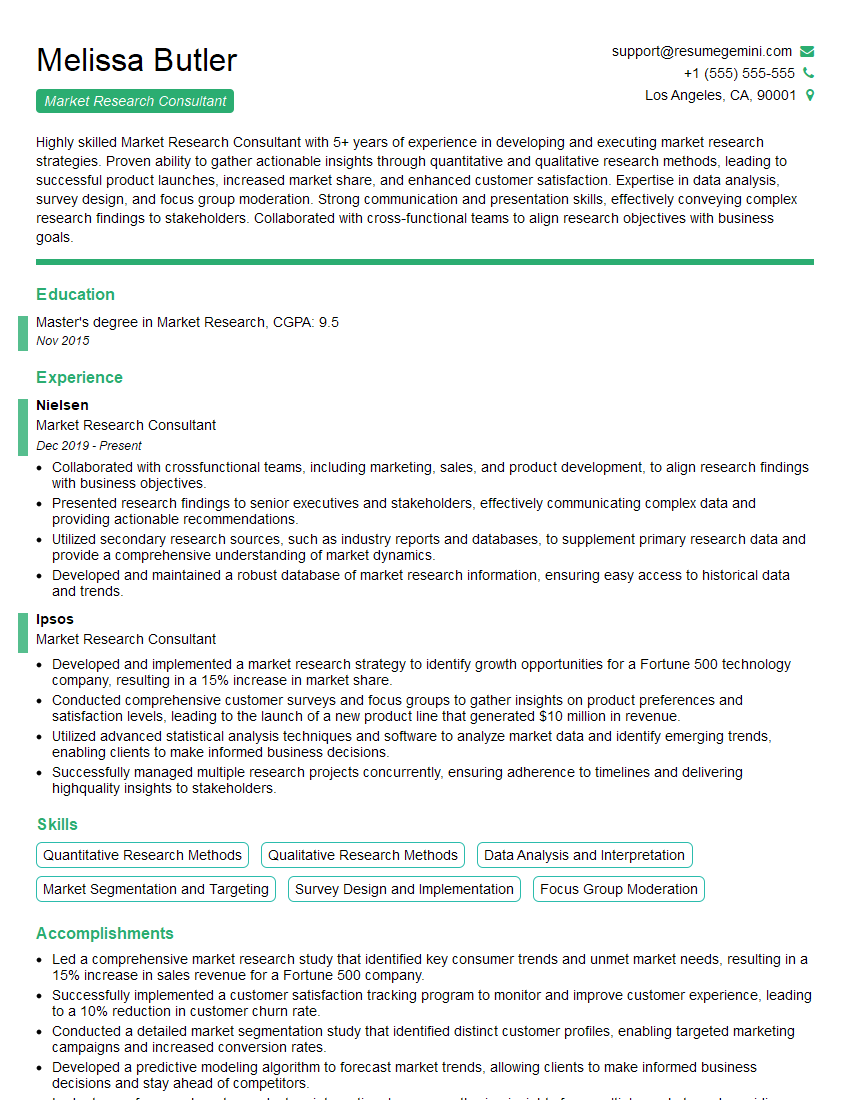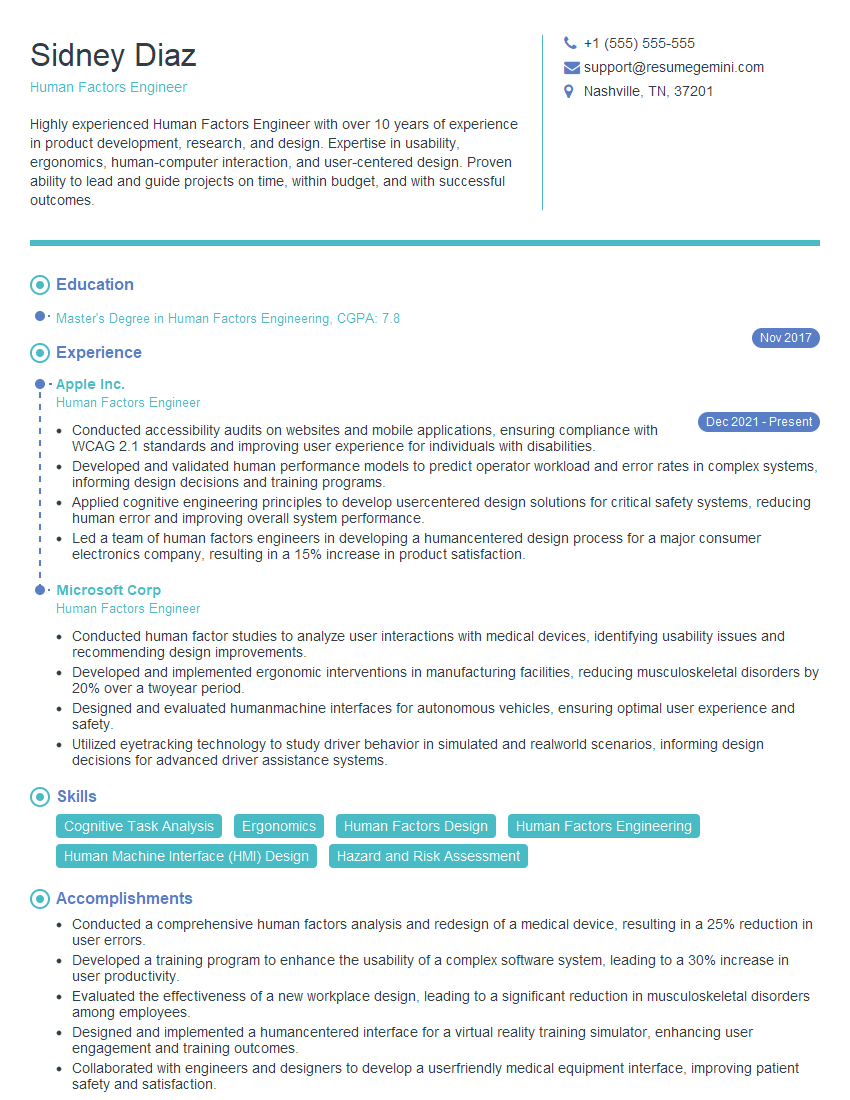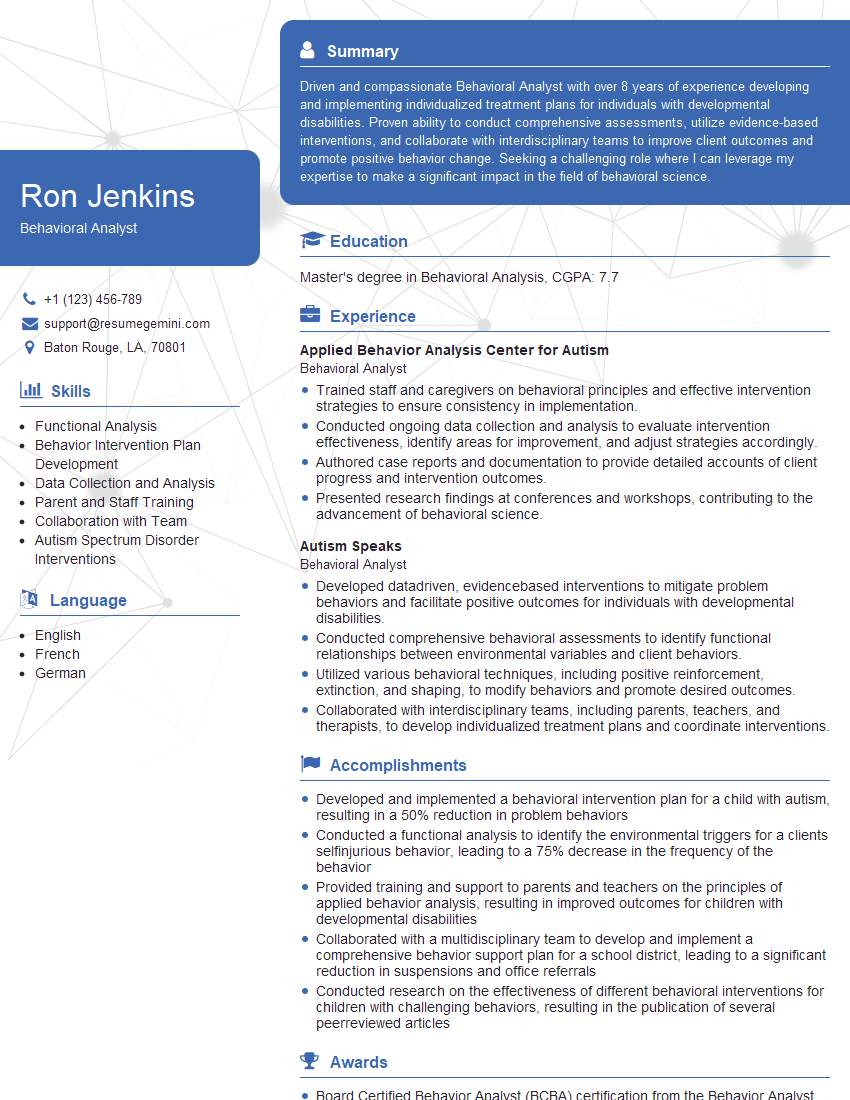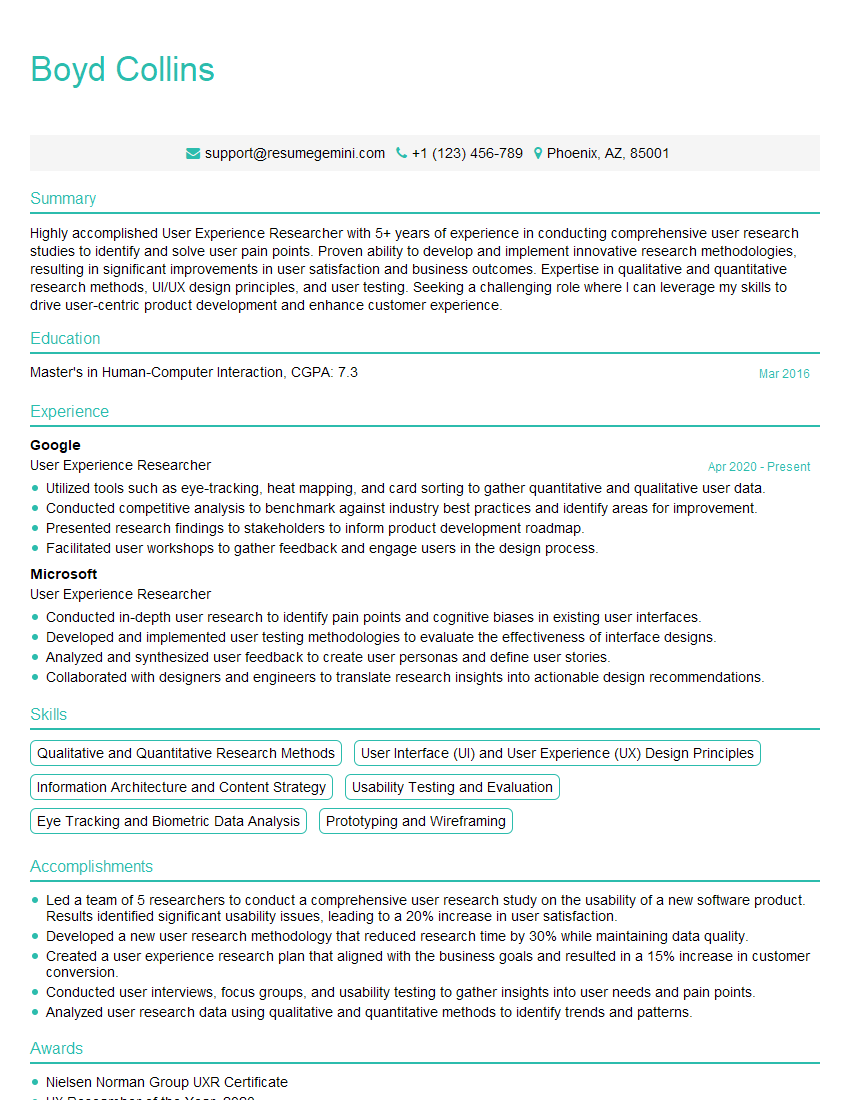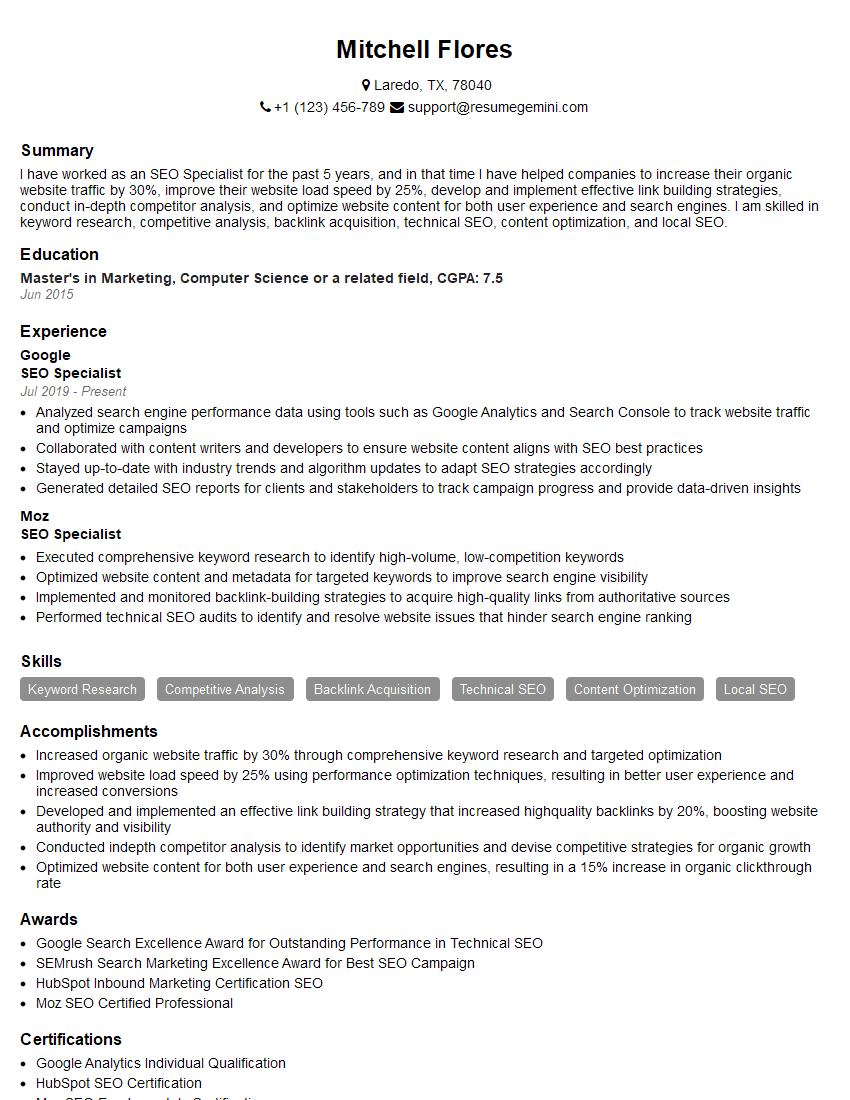Are you ready to stand out in your next interview? Understanding and preparing for Understanding Audience Psychology interview questions is a game-changer. In this blog, we’ve compiled key questions and expert advice to help you showcase your skills with confidence and precision. Let’s get started on your journey to acing the interview.
Questions Asked in Understanding Audience Psychology Interview
Q 1. Explain the difference between qualitative and quantitative audience research methods.
Qualitative and quantitative research methods represent two distinct approaches to understanding audiences. Qualitative research focuses on in-depth understanding of audience attitudes, beliefs, and motivations. It explores the why behind audience behavior. Quantitative research, on the other hand, focuses on numerical data and statistical analysis to measure audience size, demographics, and behaviors. It seeks to quantify the what and how much.
- Qualitative Methods: Think in-depth interviews, focus groups, and content analysis. These methods provide rich, nuanced data but are typically smaller in scale and less generalizable to a larger population.
- Quantitative Methods: Examples include surveys, experiments, and A/B testing. These methods generate large datasets that allow for statistical analysis and broad generalizations, but may lack the depth of understanding offered by qualitative approaches.
In practice: Imagine you’re launching a new product. Qualitative research (focus groups) might reveal why consumers are hesitant to adopt the product, uncovering underlying concerns about usability or price. Quantitative research (surveys) would then help determine how many consumers share these concerns and their demographic characteristics.
Q 2. Describe a time you used audience segmentation to improve a marketing campaign.
During a campaign for a new line of sustainable clothing, we initially used a generic marketing approach targeting all environmentally conscious consumers. The results were underwhelming. We then segmented our audience based on their level of engagement with sustainable practices (from casual interest to hardcore activists) and their preferred shopping channels (online vs. brick-and-mortar).
For the highly engaged group, we launched a targeted social media campaign featuring influencer collaborations and behind-the-scenes content showcasing the ethical sourcing of our materials. For the casually interested group, we focused on simpler messaging highlighting the product’s eco-friendly aspects and ran ads on broader platforms. The segmented approach resulted in a significant increase in conversion rates and brand awareness compared to our initial, undifferentiated campaign. We saw a 30% increase in sales and a 45% rise in positive social media mentions.
Q 3. How do you identify the key needs and motivations of a target audience?
Identifying key needs and motivations involves a multi-pronged approach combining various research methods. It’s crucial to move beyond surface-level demographics and delve into the psychological drivers of behavior.
- Surveys and Questionnaires: These help gather quantitative data on preferences and demographics, providing a foundation for understanding your audience. Open-ended questions allow for qualitative insights into motivations.
- Interviews and Focus Groups: These allow for deeper exploration of needs and motivations through direct interaction. You can probe responses and gain valuable contextual information.
- Social Listening: Monitoring online conversations, social media, and relevant forums reveals what your target audience discusses, their pain points, and their aspirations. This provides valuable unfiltered insights.
- User Data Analysis: Analyzing website analytics, app usage data, and CRM data provides clues about user behaviors and preferences that may not be readily apparent through other methods.
For example, instead of simply knowing your audience is ‘young professionals,’ you might uncover that their key motivation is achieving work-life balance, and their unmet need is efficient time management tools. This richer understanding informs product development and marketing strategies far more effectively.
Q 4. What are some common biases that can affect audience research?
Several biases can significantly skew audience research results. It’s vital to be aware of these and implement mitigation strategies.
- Confirmation Bias: This involves seeking out or interpreting information that confirms pre-existing beliefs. Researchers might unconsciously focus on data supporting their hypotheses and overlook contradictory evidence.
- Sampling Bias: This occurs when the sample used in the research doesn’t accurately represent the entire target audience. For example, relying solely on online surveys excludes those without internet access.
- Social Desirability Bias: Participants might provide answers they believe are socially acceptable rather than their true feelings. This is particularly prevalent in sensitive topics.
- Researcher Bias: The researcher’s own beliefs and expectations can influence how they design the study, interpret results, and communicate findings.
Mitigation: Employing rigorous sampling methods, using multiple research techniques, and involving multiple researchers in the analysis process can help minimize these biases.
Q 5. How would you measure the success of an audience engagement strategy?
Measuring the success of an audience engagement strategy depends on the specific objectives of the campaign. Key metrics can be grouped into three broad categories:
- Awareness & Reach: Metrics like website traffic, social media engagement (likes, shares, comments), brand mentions, and media coverage indicate how effectively your message reached your target audience.
- Engagement & Interaction: This includes metrics such as time spent on your website or app, click-through rates, email open rates, and participation in online events. These metrics indicate how actively your audience interacted with your content.
- Conversion & Behavior Change: This focuses on the desired outcomes, such as sales conversions, lead generation, donations, or changes in audience behavior (e.g., increased product usage, adoption of a new practice).
It’s crucial to set clear, measurable goals beforehand and track progress against these metrics. A holistic view across all three categories provides a comprehensive assessment of campaign effectiveness.
Q 6. Explain the concept of user personas and their application in audience psychology.
User personas are semi-fictional representations of your ideal customers based on research and data. They encapsulate key characteristics, goals, motivations, and frustrations of different user segments. They’re essential tools in audience psychology because they help you humanize your target audience, moving beyond demographics to understand their underlying needs and behaviors.
Application: Personas inform design decisions, marketing strategies, and product development. For example, a persona might be ‘Sarah,’ a 30-year-old working mother who values convenience and time-saving solutions. This understanding helps in designing user interfaces that are intuitive and easy to navigate, tailoring marketing messages to highlight convenience features, and developing products that address Sarah’s time constraints and family needs. Personas help create empathy and ensure that products and services are truly user-centered.
Q 7. How do you interpret audience data to inform design decisions?
Interpreting audience data to inform design decisions involves a systematic process:
- Data Collection & Analysis: Gather data from various sources—user feedback, website analytics, A/B testing, user interviews. Analyze this data to identify patterns, trends, and pain points.
- Persona Development: Develop user personas based on the data analysis, representing key user segments with their characteristics, needs, and behaviors.
- Design Iteration & Testing: Use the insights from data analysis and personas to inform design choices. Prototype designs and test them with users to gather feedback and iterate.
- Data-Driven Optimization: Continuously monitor usage data and user feedback after launch to identify areas for improvement and optimize the design based on real-world user behavior.
For instance, if analytics reveal high bounce rates on a particular page, this suggests a design flaw. User testing might uncover that the page is confusing or difficult to navigate. This feedback then informs design revisions, potentially simplifying the layout, improving navigation, or clarifying the content.
Q 8. What are the ethical considerations involved in audience research?
Ethical considerations in audience research are paramount. We must prioritize the privacy and well-being of participants above all else. This means obtaining informed consent, ensuring anonymity or confidentiality of data, and being transparent about how the research will be used. For example, if conducting surveys, we must clearly state the purpose, how long it will take, and how the data will be protected. We must also avoid manipulative or deceptive practices, such as posing leading questions or misrepresenting the study’s aims. Data security is also crucial; we must implement robust measures to protect personal information from unauthorized access or disclosure. Failing to adhere to these ethical guidelines can lead to reputational damage, legal repercussions, and ultimately, erode trust with our audiences.
Another key ethical consideration is avoiding bias in research design and analysis. This includes carefully selecting sampling methods to ensure representation, avoiding leading questions in surveys or interviews, and using objective analysis techniques. We must be mindful of potential biases based on gender, race, age, socioeconomic status, and other factors, actively working to mitigate their impact on our findings.
Q 9. Describe your experience with A/B testing and how it informs your understanding of audience preferences.
A/B testing is a cornerstone of my approach to understanding audience preferences. It involves creating two versions of something—a webpage, an email, an ad—and then testing them against each other to see which performs better. For instance, I might test two different headlines for an email campaign to see which one leads to a higher open rate. Or, I might test two different button colors on a landing page to determine which one results in more conversions.
I’ve used A/B testing extensively throughout my career, analyzing the results to identify patterns in audience behavior and preferences. For example, in a recent project, we tested two different versions of a website homepage. One version emphasized product features, while the other emphasized customer testimonials. The version featuring customer testimonials significantly outperformed the feature-focused version, indicating that our audience valued social proof over detailed technical specifications. This information significantly influenced our subsequent marketing and website development strategies.
The data collected through A/B testing is quantifiable and objective, allowing for a data-driven approach to decision-making. By systematically testing different variations and analyzing the results, we can gain invaluable insights into what resonates with our audience and refine our strategies accordingly. This iterative process leads to continuous improvement and better alignment with audience needs.
Q 10. How do you analyze audience feedback to improve products or services?
Analyzing audience feedback is a crucial iterative process. It begins with gathering feedback through multiple channels such as surveys, reviews, social media monitoring, focus groups, and customer service interactions. The key is to actively solicit feedback and create channels where it’s easy for the audience to share their thoughts. I then categorize and prioritize the feedback, focusing on recurring themes and sentiments. For example, if many users report difficulty navigating a website, that becomes a high-priority area for improvement.
Next, I analyze the feedback using both quantitative and qualitative methods. Quantitative analysis might involve calculating the frequency of specific comments or ratings, providing a clear measure of impact. Qualitative analysis involves in-depth review of individual comments to understand the nuances of feedback, providing rich context and depth. Based on this analysis, I develop actionable recommendations for product or service improvements. These could include website redesign, new feature development, changes to customer service processes, or improvements to marketing messaging. Finally, I implement these changes, test their effectiveness, and collect more feedback to continuously improve and adapt to the evolving audience needs. It’s a continuous feedback loop that keeps our products and services relevant and audience-centric.
Q 11. How can you identify and address unmet needs within a target audience?
Identifying unmet needs within a target audience requires a combination of qualitative and quantitative research methods. We start by deeply understanding the target audience’s demographics, psychographics, behaviors, and pain points through market research, surveys, and competitor analysis. We look for gaps in the market, areas where existing products or services are failing to meet the audience’s needs. For example, we might discover through online surveys that a significant portion of our target demographic feels frustrated by the lack of personalization in a particular service. This highlights an unmet need for a more customized approach.
Once we identify potential unmet needs, we validate them through further research, such as conducting in-depth interviews or focus groups to gather detailed insights. This helps us confirm that the need is indeed significant and that there’s a viable opportunity to address it. We then develop and test solutions to address these unmet needs, again employing techniques such as A/B testing to assess the effectiveness and appeal of different approaches. By systematically identifying, validating, and addressing unmet needs, we create products and services that are highly relevant and valuable to the target audience and helps build strong customer loyalty.
Q 12. How do you balance the needs of different audience segments?
Balancing the needs of different audience segments is a complex but essential aspect of audience psychology. It requires careful segmentation of the audience based on relevant criteria such as demographics, psychographics, and buying behavior. Once segmented, we analyze the unique needs and preferences of each segment. For example, a clothing company may segment its audience by age, lifestyle, and fashion preferences. This will reveal different needs in terms of style, price points, and marketing channels.
The key is to create a balance between personalization and standardization. While it’s impossible to satisfy every individual’s unique preferences, we can tailor our messaging and offerings to resonate with each segment without alienating others. This involves developing a core product or service that appeals to the largest segment, and then adding customized features or variations that cater to the needs of smaller segments. For example, the clothing company might offer a core line of clothing with variations in style and design to cater to different age groups and fashion preferences.
Effective communication and marketing are crucial. We must use different channels and messaging tailored to each segment, ensuring that our communication effectively conveys the value proposition to each audience segment. This may involve using different social media platforms, marketing copy, and visual elements to connect with different segments in a meaningful way. Ultimately, the goal is to create a cohesive brand identity while catering to the unique needs and preferences of various audience segments.
Q 13. Describe your approach to creating audience-centered content.
Creating audience-centered content starts with a deep understanding of the target audience. This involves conducting thorough research to understand their needs, interests, pain points, and information consumption habits. We use this information to define clear content goals – what do we want the audience to feel, think, or do after consuming our content? For example, a goal might be to increase brand awareness, drive sales, or educate users about a product or service.
Next, we craft a content strategy that aligns with the audience’s preferred formats and platforms. If our audience predominantly uses social media, we’ll focus on creating engaging short-form video content or interactive posts. If they prefer in-depth information, we might produce blog posts or white papers. The content should be valuable, relevant, and easily digestible for the target audience. This includes considering readability, visual appeal, and overall user experience.
Furthermore, we always prioritize authenticity and transparency. Building trust and fostering a strong relationship with the audience is paramount. Content should be genuine, honest, and respectful of the audience’s intelligence. Finally, consistent monitoring and analysis of content performance are crucial for refining our approach and ensuring that our content remains relevant and engaging over time. We track key metrics such as engagement rates, conversion rates, and website traffic to understand what’s resonating with our audience and adapt our strategy accordingly.
Q 14. Explain the concept of audience journey mapping.
Audience journey mapping is a visual representation of the steps a customer takes when interacting with a brand or product. It illustrates the customer’s experience from initial awareness to post-purchase engagement. It’s essentially a detailed roadmap of the customer’s experience, highlighting touchpoints, emotions, and pain points along the way. For example, a customer journey map for an online retailer might include steps such as discovering the brand through social media, browsing the website, adding items to a cart, completing a purchase, receiving the product, and leaving a product review.
Creating a customer journey map involves several key steps: First, define your target audience and their goals. Then, identify all the touchpoints that a customer has with your brand throughout the journey, including websites, social media, email, customer service, and physical stores (if applicable). Next, describe the customer’s actions, thoughts, and emotions at each touchpoint. Consider both positive and negative experiences. Finally, visualize the entire journey using a flowchart or other visual representation. This helps to identify areas where the customer experience can be improved. For example, if the map reveals a high abandonment rate during checkout, it signals a need to optimize the checkout process.
By creating a clear visual representation of the customer journey, we can easily identify opportunities to improve the customer experience and increase customer satisfaction. The insights gained from audience journey mapping directly inform the development of better products, services, and marketing strategies, leading to improved customer engagement and increased loyalty.
Q 15. How do you utilize social listening to understand audience sentiment?
Social listening is the process of monitoring online conversations to understand audience sentiment towards a brand, product, or industry. It involves tracking mentions on social media platforms, forums, blogs, and news sites. I utilize this by employing dedicated social listening tools that track keywords and hashtags relevant to my target audience. These tools provide data on the volume of mentions, sentiment (positive, negative, neutral), and the topics being discussed.
For example, if I’m launching a new sustainable clothing line, I’d track mentions of terms like “eco-friendly fashion,” “sustainable clothing,” and competitor brand names. The data reveals whether the conversation is predominantly positive, negative (e.g., concerns about pricing or sustainability claims), or neutral. This informs adjustments to our marketing strategy, product development, or public relations efforts. Analyzing the context of the conversations—who is saying what, where, and why—helps understand the nuances of audience sentiment.
Career Expert Tips:
- Ace those interviews! Prepare effectively by reviewing the Top 50 Most Common Interview Questions on ResumeGemini.
- Navigate your job search with confidence! Explore a wide range of Career Tips on ResumeGemini. Learn about common challenges and recommendations to overcome them.
- Craft the perfect resume! Master the Art of Resume Writing with ResumeGemini’s guide. Showcase your unique qualifications and achievements effectively.
- Don’t miss out on holiday savings! Build your dream resume with ResumeGemini’s ATS optimized templates.
Q 16. How do you adapt your communication style to different audience demographics?
Adapting communication style to different demographics requires understanding the unique characteristics of each group. This includes age, cultural background, education level, and online behavior. Consider the language used – younger audiences might respond better to informal language and slang, while older demographics might prefer a more formal tone.
For instance, a campaign targeting Gen Z might utilize short-form video content and meme culture on platforms like TikTok and Instagram, employing a conversational and playful style. In contrast, a campaign targeting Baby Boomers might focus on more traditional media like print or television, with a respectful and informative approach. Analyzing audience data, including age, location, and interests from platforms like Facebook Ads or Google Analytics, provides essential insights for tailoring the message and media accordingly. The key is to ensure authenticity – don’t try to force a style that doesn’t feel genuine to the brand or the specific audience.
Q 17. Describe your experience using analytics tools for audience research (e.g., Google Analytics).
I have extensive experience using Google Analytics and other analytics platforms for audience research. Google Analytics, for instance, offers invaluable insights into website traffic, user behavior, and demographics. I utilize its features to understand which pages are most popular, how users navigate the site, and what their geographic location and interests are.
Specifically, I look at metrics such as bounce rate (percentage of visitors who leave after viewing only one page), time on page, and conversion rates. Low bounce rates and high time on page indicate engaging content. Analyzing conversion rates helps evaluate the effectiveness of calls-to-action. Google Analytics’ demographic and interest reports provide a breakdown of visitor characteristics, allowing me to refine targeting efforts and personalize content. Combining Google Analytics data with data from other sources, such as CRM systems and social media analytics, creates a holistic picture of my audience.
Q 18. How do you identify and address audience pain points?
Identifying audience pain points is crucial for creating relevant and effective solutions. I use a multi-pronged approach. Firstly, I analyze customer feedback through surveys, reviews, and social listening. Secondly, I conduct in-depth interviews and focus groups to gain a deeper understanding of their challenges. Thirdly, I study competitor offerings to understand unmet needs in the market.
For example, if customer reviews consistently mention difficulties using a product feature, this indicates a pain point that needs addressing—perhaps through a revised design, improved user instructions, or additional support resources. Once a pain point is identified, addressing it directly in my communication or product development can significantly improve customer satisfaction and brand loyalty. Prioritizing the resolution of these pain points becomes a key differentiator in the market.
Q 19. How do you measure audience engagement on social media?
Measuring audience engagement on social media involves tracking several key metrics. These include likes, comments, shares, and retweets—these show immediate engagement with the content. Beyond that, I also track metrics such as reach (the number of unique users who saw the post), impressions (the total number of times the post was displayed), and click-through rates (percentage of users who clicked on a link in the post).
Engagement is not just about the volume of interactions, but also the quality. Analyzing the sentiment expressed in comments helps understand audience perception. For instance, a high number of negative comments might indicate a need to revise the content strategy. Tracking these metrics across different platforms and over time provides insights into what resonates most with the audience, allowing for optimization of social media strategies and content creation.
Q 20. Explain your understanding of cognitive psychology and its relevance to audience understanding.
Cognitive psychology studies mental processes such as attention, memory, and perception. This is directly relevant to understanding audiences because it helps explain how people process information and make decisions. Understanding cognitive biases, for example, is crucial. People tend to favor information that confirms their existing beliefs (confirmation bias), and are more likely to remember information presented in a memorable way (availability heuristic).
By applying principles of cognitive psychology, I can craft more effective messaging. This means using clear and concise language, structuring information logically, and employing visual aids to enhance comprehension. For instance, understanding memory limitations means delivering information in bite-sized chunks rather than overwhelming the audience with large amounts of data at once. Addressing cognitive biases in communication might involve presenting different perspectives to encourage critical thinking.
Q 21. How do you identify and target niche audiences?
Identifying and targeting niche audiences requires deep research and understanding of specific demographics and interests. I use several methods including analyzing competitor strategies, identifying relevant online communities, and employing advanced search techniques.
For instance, if I’m marketing specialized hiking equipment, I’d identify niche audiences based on factors like experience level (beginner, intermediate, expert), preferred hiking terrains (mountain, trail, desert), and specific gear preferences (lightweight backpacking, mountaineering, etc.). I’d then utilize targeted advertising on social media platforms and search engines, focusing on keywords and demographics specific to these niche groups. Joining relevant online forums and engaging in conversations within those communities helps build trust and relationships with potential customers. This targeted approach increases the efficiency of marketing efforts and generates a higher conversion rate.
Q 22. What are some common challenges in audience research, and how do you overcome them?
Audience research, while crucial, presents several challenges. One significant hurdle is obtaining truly representative data. Sampling bias, where the sample doesn’t accurately reflect the entire target audience, can skew results. For instance, relying solely on online surveys might exclude individuals with limited internet access, creating a skewed demographic representation. Another challenge is interpreting qualitative data – understanding the nuances of open-ended responses and identifying recurring themes requires careful analysis and interpretation. Finally, evolving audience preferences mean research findings can quickly become outdated.
To overcome these challenges, I employ a multi-pronged approach: I use diverse data collection methods (online surveys, focus groups, interviews, social media listening) to ensure a broader representation. Rigorous sampling techniques, like stratified sampling, help mitigate bias. For qualitative data, I use qualitative data analysis software to assist with coding and identifying patterns. To combat obsolescence, I conduct regular, smaller-scale research studies to track shifting trends, allowing for agile adjustments to campaigns and strategies.
Q 23. Describe a time you had to adjust your approach based on unexpected audience reactions.
During a campaign launch for a new sustainable fashion line, our initial marketing materials focused heavily on the eco-friendly aspects. While this resonated with a segment of our audience, we observed unexpected negative feedback from a significant portion who felt the messaging was preachy and elitist. Their comments indicated a preference for highlighting the product’s style and quality, rather than solely its environmental credentials.
We promptly adjusted our approach. We re-evaluated our messaging, shifting the emphasis to the product’s design and aesthetic appeal while subtly incorporating the sustainability aspects. We also incorporated more user-generated content showcasing the clothes being worn in everyday situations, making the brand feel more accessible. The result was a significant improvement in engagement and purchase intent.
Q 24. How do you use audience data to predict future trends?
Predicting future trends requires a combination of analyzing historical data and understanding current societal shifts. I start by examining past audience behavior – analyzing sales figures, website analytics, social media engagement, and survey results. This helps identify patterns and recurring preferences. Next, I integrate external data sources, such as economic reports, demographic projections, and cultural trend reports, to understand the broader context influencing consumer behavior.
For example, noticing a consistent increase in engagement with sustainable products over the last few years, combined with growing awareness of environmental issues (external data), allows me to predict continued growth in demand for eco-friendly products. By combining quantitative data analysis with qualitative insights (from focus groups or interviews), I can refine these predictions and identify specific niches within the trend.
Q 25. Explain the role of empathy in understanding audience psychology.
Empathy is paramount in understanding audience psychology. It allows us to move beyond simple data points and connect with the emotional drivers behind audience behavior. Instead of just knowing *what* people do, empathy helps us understand *why* they do it. This involves stepping into the shoes of our audience members and considering their perspectives, motivations, and needs.
For example, if a product isn’t selling well, simply analyzing sales data isn’t enough. Empathy guides us to consider factors such as the audience’s perceived value, their potential frustrations with the product, and their emotional connection (or lack thereof) to the brand. This deeper understanding allows for more effective solutions, such as redesigning the product to better meet user needs or adjusting marketing strategies to address emotional concerns.
Q 26. How do you ensure data privacy and ethical considerations in your audience research?
Data privacy and ethical considerations are central to my work. I adhere strictly to data protection regulations (like GDPR and CCPA), ensuring all data collection and processing are compliant. I obtain informed consent from participants before collecting any data and clearly communicate how their data will be used. Anonymization and data aggregation techniques are employed to protect individual identities wherever possible.
Transparency is key; I’m always open about my research methods and findings, ensuring that the audience understands how their data is used. I also maintain rigorous data security measures to prevent unauthorized access or breaches. Ethical considerations extend to avoiding manipulative or misleading practices in research and ensuring that findings are presented accurately and without bias.
Q 27. How do you stay current with the latest trends and technologies in audience psychology?
Staying current involves a continuous learning process. I regularly attend industry conferences, webinars, and workshops to learn about new research methods and technological advancements. I subscribe to relevant journals and publications and actively participate in online communities focused on audience psychology and market research.
I also make it a point to explore new technologies, such as AI-powered sentiment analysis tools and predictive modeling software, to improve the accuracy and efficiency of my research. This proactive approach keeps me at the forefront of my field, ensuring my work is both relevant and impactful.
Key Topics to Learn for Understanding Audience Psychology Interview
- Audience Segmentation: Learn to identify and categorize different audience groups based on demographics, psychographics, and behavioral patterns. Consider how these segments might react differently to various communication strategies.
- Motivational Theories: Explore frameworks like Maslow’s Hierarchy of Needs and the Theory of Planned Behavior. Understand how these theories can help predict audience behavior and shape persuasive messaging.
- Cognitive Biases: Familiarize yourself with common cognitive biases (confirmation bias, anchoring bias, etc.) and how they influence audience perception and decision-making. Learn to mitigate their impact on your communication.
- Emotional Intelligence: Understand the role of emotions in communication and how to tailor your message to resonate with the target audience’s emotional state. Practice empathy and perspective-taking.
- Communication Channels & Strategies: Analyze the effectiveness of different communication channels (e.g., written, visual, verbal) for various audience segments. Develop strategies for tailoring your message to each channel.
- Persuasion Techniques: Explore ethical and effective persuasion techniques, including framing, storytelling, and social proof. Understand the ethical implications of using persuasion techniques.
- Data Analysis & Interpretation: Learn to analyze audience data (e.g., surveys, feedback) to understand audience preferences and adjust communication strategies accordingly. Practice interpreting data to inform decision-making.
- Ethical Considerations: Discuss the ethical implications of understanding and influencing audience psychology. Learn to apply this knowledge responsibly and avoid manipulative tactics.
Next Steps
Mastering audience psychology is crucial for career advancement, enabling you to communicate effectively, build strong relationships, and influence decisions. A well-crafted resume is your first impression – make it count! An ATS-friendly resume significantly increases your chances of getting noticed by recruiters. To create a compelling and effective resume that highlights your understanding of audience psychology, leverage the power of ResumeGemini. ResumeGemini provides a user-friendly platform to build professional resumes, and we offer examples of resumes tailored to showcase expertise in Understanding Audience Psychology. Take the next step towards a successful career – build your best resume with ResumeGemini.
Explore more articles
Users Rating of Our Blogs
Share Your Experience
We value your feedback! Please rate our content and share your thoughts (optional).
What Readers Say About Our Blog
Hi, I represent an SEO company that specialises in getting you AI citations and higher rankings on Google. I’d like to offer you a 100% free SEO audit for your website. Would you be interested?
Dear Sir/Madam,
Do you want to become a vendor/supplier/service provider of Delta Air Lines, Inc.? We are looking for a reliable, innovative and fair partner for 2025/2026 series tender projects, tasks and contracts. Kindly indicate your interest by requesting a pre-qualification questionnaire. With this information, we will analyze whether you meet the minimum requirements to collaborate with us.
Best regards,
Carey Richardson
V.P. – Corporate Audit and Enterprise Risk Management
Delta Air Lines Inc
Group Procurement & Contracts Center
1030 Delta Boulevard,
Atlanta, GA 30354-1989
United States
+1(470) 982-2456
